Climb up Kilimanjaro via Machame Route.
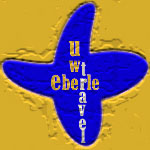
August 24th, 1999
Leaving Munich early in the morning, we arrived at Kilimanjaro International
Airport early evening. We, meaning some of my ex-colleagues from Vereinsbank
Group; Georg and his girlfriend Michaela, Ernst, Peter (Thilo) and me.
The hour drive to the hotel in the town of Moshi made it
clear to us that we are in a different world. The last 2 miles to the
hotel took some 20 - 25 minutes, this thing which is considered a road
in Africa was just an accumulation of bumps. The two in our group, who
have never visited such an emerging country, couldn't believe that there
could be a great hotel at the end of the road. Then, we saw a lot of lights
and a building behind an 8 feet high wall. We passed through the gate
and found a beautiful tropical garden bar just in front of us. Suddenly
the mood of everybody picked up sharply and we went for some drinks before
we called it a day.
August 25th, 1999
After an early breakfast we've sorted out our gear for the trip and took the bus towards the Machame gate, our starting point at 1800 meters altitude. Some 2 miles before the Machame Gate the bus stopped. There we met our guide Felix, the two assistant guides, the cook and 8 other porters. From there we walked up to the gate. After our registration, Edwin--one of the assistant guides - took us into the rain forest. The trail starts nice and easy, 2 -3 meters wide, but got more difficult after 1 ½ hours. It got really muddy and you had to watch out that the water and mud didn't flow into the trekking shoes. I started the trip with a torn muscle injury sustained in austria a week and a half before and decided to see how my leg holds up. Going pretty fast up to 2.650 meter altitude I relaxed happily - everything was holding up well. But at the same time I realized that I went up too fast, at that altitude you better slow down and take it easy. I took a break and a couple of minutes later the others showed up. Their speed was too high as well and Peter looked pretty tired & stressed. So Peter and I took it easy and walked up the rest of the day with lots of breaks and "Pole, Pole" (Swahili: slowly, slowly). We arrived at the Machame camp at around 3.000 meters altitude at 4:00 p.m. There we met most of our porters and the cook was working hard on dinner already, it is no easy task to satisfy a bunch of hungry Bavarians.
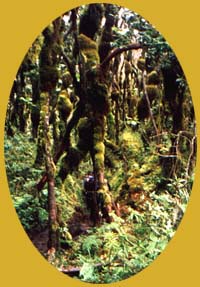
August 26th , 1999
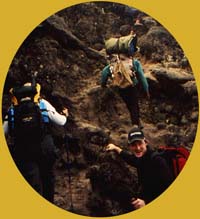
We had reached the end of the rain forest the day before and reached
the 2nd "vegetation zone" up the Kilimanjaro now, the moor. Starting at
slightly under 3.000 meters altitude we targeted the Shira camp at 3.840
meters which results in a gain of 900 meters altitude.We thought we went
up slowly, but retrospectively we probably went up too fast again and
didn't take enough brakes. Peter and I felt the extreme UV-radiation at
Kili and I got in trouble when we arrived at Shira Camp. I probably had
a sun stroke and went in the tent immediately to get some rest. This remained
a problem for me during the next two days. My sun hat wasn't resistant
against the UV-radiation and every afternoon my forehead was burning with
fire. Sun creme with a factor of 30 couldn't solve the problem.
Besides that, everybody else had some problems with the altitude, with a little headache coming up. We didn't really get that warning signal, but it should have been a clear sign that we should go "Pole, Pole".
August 27th, 1999
Next morning we started towards Barranco camp. Slowly gaining altitude
we went into the next vegetation zone, a black sand and stone desert.
Moving up slowly we were praying for a lunch break. But the trail was
just going up and down and up and up.... Finally at 01:30 p.m. we arrived
for our lunch break at the highest point for the day at 4.450 meters.
Michaela admits that she felt pretty lousy, with a strong headache. We
decided to shorten lunch to just 15 minutes, to go down to Barranco camp
as fast as possible. But Michaela's altitude sickness got worse at a rapid
speed. Finally she was admitting that she had problems already in the
afternoon the day before and early in the morning, but thought it didn't
come from the altitude. Michaela didn't have much experience in mountains
before, and I think after the easy first days she took the danger of the
altitude too lightly. There is one rule which the doctors at the altitude
hospital in the Everest Region told me and Georg on our trip last year
and everybody should really take it to the heart: whatever sickness you
have, as long as it is not otherwise proved, you work on the assumption
of altitude sickness! So, we got a bit nervous and gave her ½ a diamox
(a special high altitude medicine) and shortly afterwards another ½. She
finally had to vomit, another sign of altitude sickness. She said, every
step she did she felt like someone was drumming on her head. Nevertheless,
we've been happy, because after lunch the trail was really going down
fast and we have reached camp at low altitude (3900 meters) in 1 ½ hours.
Michaela went in her tent immediately, still feeling very lousy. She finally
was listening to us and was drinking lots of water, tea and soup. This
is probably still the best treatment against altitude problems: liquids,
liquids, liquids. Michaela probably didn't drink the required daily dose
of 4-5 liters of water, which the body needs. (There is one good test:
if your urine is clear and not yellow, you had enough water).
We checked, if there is a straight way down the mountain, just in case
it doesn't get better. But she felt a bit better towards the end of the
day, and has been O.K. next morning.
We had a heavy discussion before dinner, about the mistakes we've been
making the days before, and decided on some changes: decreasing our speed
further, more and longer breaks, a closer observation of each other and
a signal to everybody if someone doesn't feel well.
August 28th, 1999
Breakfast wasn't breakfast, breakfast is the nickname the local guide
gave the wall we had to go up next morning. No real climbing, but a nice
alternative to the slow trekking before. We climbed up very slowly to
reach the top of the wall after 1 ½ hours. Lots of rest at the Peak and
another two hours to the camp in Karanga Valley. The sky cleared at the
end of the day and we saw clearly in front of us the south face of Kilimanjaro.
Another fascinating thing for us was the sound of the vultures wings beating
above our heads and tents, which was really loud. Did they smell food??
Again, "Pole, Pole" (for some participants we walked too slowly now), we went further up the mountain. By 3 p.m., after 5 ½ hours of walking, we reached Barafu camp. But we knew already, that there is not a lot of time for rest. The wake-up call was to be expected for 11:30 p.m.
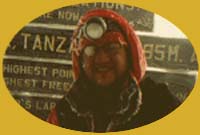
August 30th, 1999 - Summit Day
After some tea and cookies we started at 00:20 a.m. at 4.600 meters altitude
towards the Uhuru Peak of Mount Kilimanjaro. After a lot of fog and light
snowfall in late afternoon the weather got better and it cleared up. We
started very "Pole, Pole" and accordingly have been gaining altitude only
very slowly. For Peter it was too slowly, and he asked at 5.250 meters
if someone would go up with him at a faster pace. Not sure if this is
really the right thing, I decided to join him anyway. Thomas, one of the
assistant guides, was leading us further up at almost double the speed
now. After we gained 250 meters altitude very fast I had to stop Peter.
I thought that if we continue with that kind of speed we will not be able
to get up the mountain. So we slowed down again, but moved steadily towards
Stella Point. At Stella Point (ca. 5.700 meter) the weather turned really
ugly. We came into a snow storm with winds coming from the side with an
estimated 100 km per hour (60 mph). Peter and I decided to go straight
ahead towards Uhuru Peak. But than I saw Michaela and Georg 50 meters
behind us and decided to wait for them (Their guide found a shorter way
up).
I had a discussion with Georg if we should go ahead or if it is too risky.
For that kind of weather you need face masks, expedition gloves and plastic
mountain shoes. We had fears that we could get frostbites. But then we
talked with the guide and he confirmed our suspicion that this is probably
just a wind channel and it gets better further up. At one point, the wind
got so strong that Peter fell down from a gust of wind. Nevertheless,
Peter moved ahead and reached Uhuru Peak first. I followed him with Michaela
(she was one of the strongest that day) and Georg followed us 100 meters
behind. Being normally the strongest of the group, he himself confirmed
afterwards that he really had been at the edge, at the boarder of his
capabilities. But, I think it really helped him that his girlfriend Michaela
was in front of him, keeping his ambition to succeed strong. It took us
35 minutes from Stella point to the highest point at Kilimanjaro, the
Uhuru peak (5895 meters). The wind subsided and was sometimes in our back,
pushing us up to the summit. There, we met Peter again, just on the way
to descend the mountain.
At 7 a.m. in the morning it was too cold to really celebrate, but at
least it was a little warmer and less windy now. Georg felt a tickling
in his middle finger and realized that his middle finger became slightly
frozen and was just warming up. We took some obligatory pictures and turned
around. After 200 meters we met Ernst with his guide Felix. Ernst was
totally exhausted but 5 minutes later the two reached the peak.
Under Stella Point the weather got better again and we've been able to
stop and rest for a while. Another 1 ½ hour down the mountain we reached
our tents again and went in to take a nap. Another 1 ½ hour down the mountain
we reached our tents again and went in to take a nap. But we couldn't
call it a day,
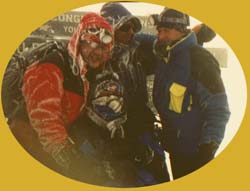
August 31st, 1999
What we thought as an easy 2 hours down the mountain got really exhausting at the end. The mud was knee-deep and very slippery and as rain setting in we fell down a couple of times. We looked like pigs when we arrived at the Mweka-Gate. Here we bought our "Just done it - Kibo 99" T-Shirts. Feeling unhappy, that we've been so exhausted the day before and unable to really party we decided for some drinks at the gate. After 1 ½ hours the place run out of beer, and we had to go further down this time with a help of a van. There we were, 15 people in a van made for 8, singing the Kilimanjaro song and getting slightly drunk. This was somehow the real highlight for us, finally getting a closer contact to guides and porters and not being separated anymore.
PS: I'm going to write an article about the behavior on the mountain in the context of the Altitude sickness next week which I will publish on my homepage, too.